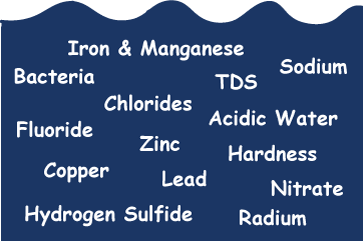Drinking water treatment plant operators work around the clock to provide you with safe drinking water. Even with the best efforts, issues can sometimes occur for several reasons.

These reasons include:
- Contaminants getting into the source of your drinking water
- Improperly maintained distribution system (pipes, fixtures, etc.)
- Drinking water that is not properly treated or disinfected
- Issues caused by your home plumbing system
If you're concerned about your drinking water, you may want to have it tested. Below is more information to help you decide.
Signs & Effects of Common Drinking Water Concerns
If you notice a change in your drinking water, you may want to have it tested. Below is information to help you decide what contaminant may be the concern.
| Containment | Signs & Symptoms | Effects |
|---|---|---|
| Baceffectsteria | No signs or symptoms | Gastrointestinal illness, which may include nausea, vomiting, abdominal cramps, & diarrhea |
| Chlorides | Salty Taste | Not generally considered harmful to humans or animals. May contribute to the corrosion of household appliances and plumbing. |
| Copper | Blue-green stain on plumbing fixtures Very bitter, medicinal taste found when above 1.3 mg/l | Short-term exposure can cause stomach cramps and intestinal discomfort Long term exposure may cause liver and kidney damage |
| Fluoride | Children exposed to excessive amounts may develop white or brown spots on their teeth. | Excessive fluoride is a concern only when water is used for cooking and drinking. |
| Hardness | Soaps won't lather. Excessively hard water will cause a hard, chalky scale to form when the water is heated. | Not considered a health hazard. Excessive hard water may cause reduced water heater capacity leading to a burn-out. |
| Hydrogen Sulfide | Rotten egg odor Sulfur taste. | Speeds up the corrosion of metal plumbing materials. |
| Iron & Manganese | Bitter, metallic taste Stains on plumbing fixtures, appliances, and laundry | No evidence to indicate the amount normally found in a well is harmful. |
| Lead See information on high-risk groups | Corrosion of home plumbing materials containing lead | Damage to brain, nervous system, kidney, and red blood cells. Pregnant women, fetuses, infants and young children are at a greater risk. Permanently stunt growth if children are overexposed during growing stage. |
| Nitrate See information on high risk groups | In babies: shortness of breath, blueness of skin. In healthy adults: relatively little effect, even when consumed at large quantities. | Infants, pregnant women, individuals with reduced gastric acidity, and individuals with a hereditary lack of methemoglobin reductase. Causes severe oxygen deficiency and can lead to death for those at high risk. |
| Radium | No signs or symptoms | A lifetime of drinking water with high levels of radium may increase the risk of certain cancers. |
| Sodium | Salty taste, if sodium & chlorides are present Bitter taste, if sodium & sulfates are present | Increases blood pressure that can eventually lead to hypertension. |
| Total Dissolved Solids (TDS) | Salty taste when chlorides are present. Bitter taste when sulfates are present. Medicinal taste when bicarbonates are present | Temporary laxative effect may occur after drinking water when sulfates make up most of the TDS. Household plumbing and appliances will deteriorate faster. |
(Source: DHEC's Common Water Quality Problems and their Treatment and EPA)
Information for High Risk Groups
Some populations are at a greater risk of experiencing health effects when exposed to certain contaminants. These sensitive populations include:
- Pregnant women
- Fetuses
- Infants
- Young children
- Individuals with reduced gastric acidity
- Individuals with a hereditary lack of methemoglobin reductase
These groups (listed above) should be particularly careful about exposure to the following contaminants:
Additional Information & Links
- DHEC Flushing Fact Sheet
- Where do these contaminants come from?
- Basic information about drinking water contaminants
- More information about health effects of contaminants in drinking water
- Testing your drinking water
- EPA's Secondary Drinking Water Regulations are guidelines for contaminants that may cause cosmetic or aesthetic effects in drinking water.
Contact
- Richard Welch, Jr. P.E., Manager, Drinking Water & Recreational Waters Compliance, (803) 898-3546

